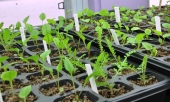Everyone has their own way of doing things. Either you figure it out on your own or imitate what someone else is doing. Greenhouses are not all that common so it may be hard to find someone to show you what's going on. There's nothing difficult here. This
project took about 30 minutes because I was messing with a camera. To do it without the camera only takes a few minutes.
My cells and trays were getting pretty old and torn up so I picked up some replacements.
Let's get to work...clear off the potting bench, place a tray front and center.
A single tray is pretty flimsy. Once filled with soil and
water these will weigh 15-20 pounds. Breakage is a problem. When picked up the sides have a tendency to crack near the center, allowing water to drain and making them clumsy to lift. I double them up to offer strength. The old trays that are cracked or have holes worn through the corners can still earn their keep when used on the inside.
Place cells. Use them old ones first. These inserts will arrive connected as a sheet. As they are used, seeds will sprout at different time, some won't sprout at all. I find seperating the 6-packs makes for easy handling. They stack easily when space is at a premium.
I've been using these cells for years. They are not made to last forever. With the new cells on hand, when I come across busted inserts I take them out of service. The last time I bought some cells was in '07.
Fill the inserts with potting soil. My mix is about a third sand (what we call topsoil in Florida), around a third
compost, around a gallon of peat moss, plus
enough leaf mold to fill the rest of a wheelbarrel. All this is sifted through a 1/4" mesh. To the wheelbarrel I add a gallon
bucket 50/50 blend of perlite and vermiculite. Mix it all up with a shovel, store in 5 gallon buckets. The perlite and vermiculite has been around for a few years. These are added to prevent compaction and to retain moisture. The compost and leaf mold retain plenty of moisture. The sand does not compact as would a clay soil. When my supply runs out, I'll skip the perlite and vermiculite. Leaf mold serves as an excellent substitute for peat moss, so I'll be leaving that out from now on. I scoop the soil from the bucket with a cup, dump it on the tray, spread it around with my hand.
If you missed a busted insert, it will let you know. Stored in buckets, this potting mix dries out and will flow freely.
I tamp down the soil by lifting the tray and setting it down with a gentle nudge. Fill low spots, scrape off high spots. It ain't gotta be perfect.
Starting some spinach today. This is Bloomsdale Long Standing. One of my seed suppliers is
Sustainable Seed Company. Heirloom, open-pollinated, non-GMO, with Certified Organic available. I find their ethics, prices and customer service appealing.
I aim for the center of the cell. Close enough is good enough. A general rule of thumb is 1 cell, 1 seed. Just before I started this spinach I started some Amish Snap Peas. I could not get the volume of peas I wanted, just a single packet. That makes them Golden seeds and I need to maximize my yield in order to keep the cultivar going. When seeds are cheap and plentiful, several seeds per cell demands the additional step of thinning. I don't want the extra work. 1 cell, 1 seed. I'll transplant those plants that are worthy.
Sprinkle peat moss over the top. These trays will be in a warm, moist environment. The acidity of the peat moss retards algae growth. The perlite serves as a guide letting me know how much peat has been applied. I find a light dusting is all that is needed.
Add water to the tray. This potting mix is bone dry. It will slurp up half a gallon of water by tomorrow.
I use a pump sprayer to moisten the surface. The spray tip can be adjusted from stream to mist. I use more of a mist so the seeds don't get blasted away. The water in the tray will take time to wick up to reach the seeds. I spray the top because that's where the seeds are. Get em good and damp.
Add a label. Place the tray in a handy spot. These will show up in a few days.
This is 72 seeds. A germination rate of 85% suggests 60 plants.
Experience says most of them will show up. I'll end up transplanting 65-70 into the beds. Starting seed in the
greenhouse offers numerous advantages:
-Minimal seed use and seed cost. Sowed in the growing beds, the survival rate is reduced and more insect damage can result. These plants will spend a couple weeks at least in the protection of the
greenhouse.
-I can water the seedlings in a small area quickly and with little water. If these spinach were started in the beds at optimum spacing they would take up 20 square feet. The tray takes up 2 square feet, and I can stack shelves. Even if I repot these plants into larger containers to give them more time hey still take up a fraction of the space they require in the beds.
-I can water the seedlings in a small area quickly and with little water. If these spinach were started in the beds at optimum spacing they would take up 20 square feet. The tray takes up 2 square feet, and I can stack shelves. Even if I repot these plants into larger containers to give them more time hey still take up a fraction of the space they require in the bed.
-When it is time to transplant, these plants will have
roots several inches long, giving them excellent resistance to dry conditions. The Leaves and stems will be several inches high and can be mulched immediately. This gives them a survival advantage over weeds. Weeds will be shaded. Water and nutrients in the soil will be available for the crops.
-Small seedlings can be consumed or destroyed easily by pests. A cutworm, for example, can take out a small plant. By setting out a larger plant, a cutworm may only knock off a couple of leaves. I'll have a chance to take action before the crop is laid waste.
-Space is at a premium. It takes considerable effort and resources to develop a growing bed, even with no-till methods. Using transplants there are no empty spaces. Plants can be placed at optimum distance. That limited space is put to use.
-Time is at a premium. As soon as one crop comes out, the next rotation can go right in, and do so with several weeks of growth. I can grow crops all year. If I knock a month of time off of each rotation, I can easily gain an entire crop each year.
-I can work in the greenhouse at night, during storms, and when it's just too damn cold out there.

 3
3




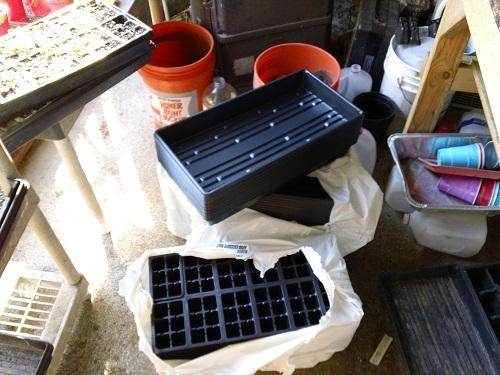

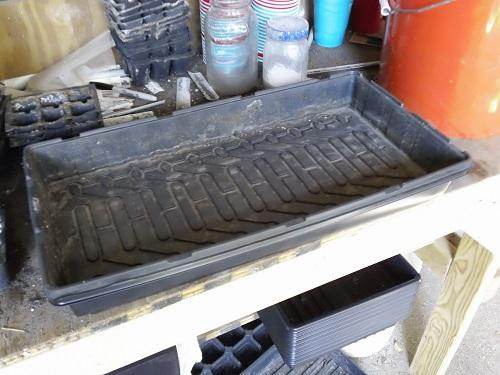

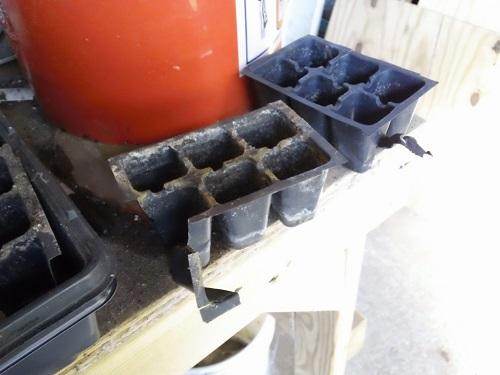
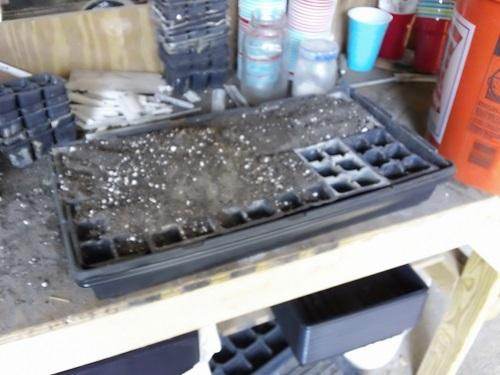
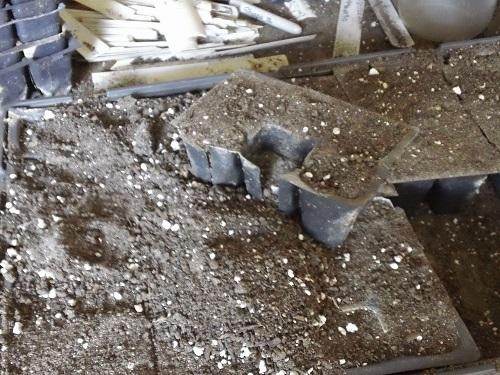
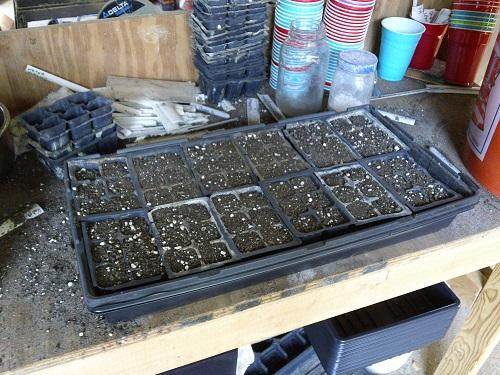
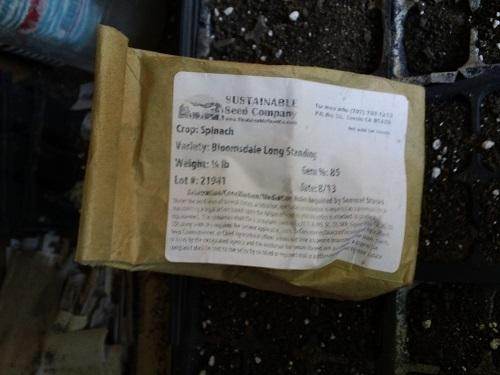
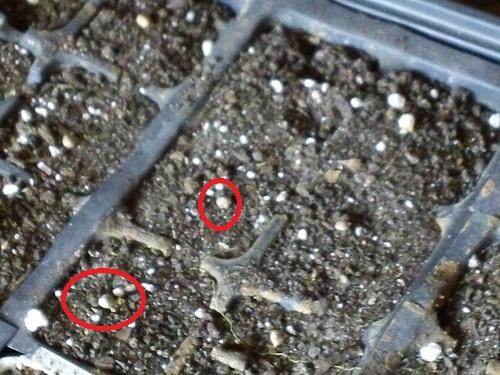
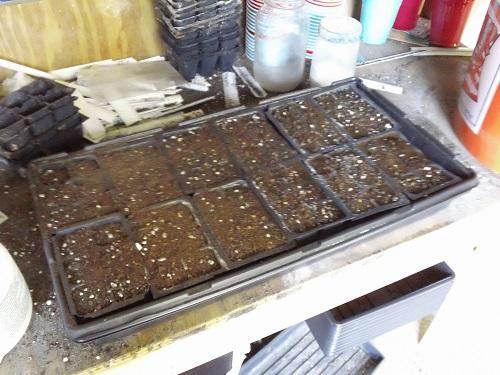
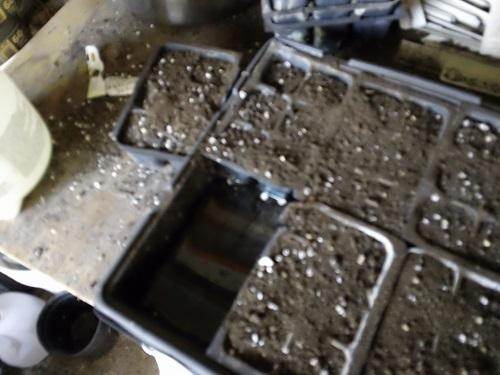

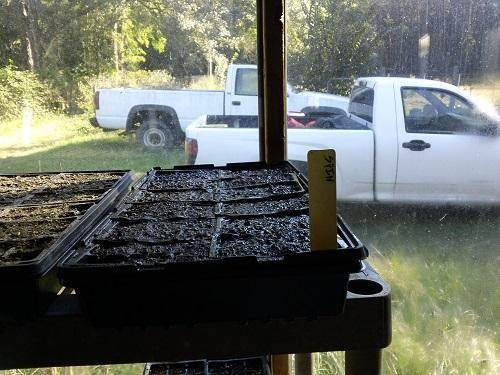





 1
1





